**UPDATE LATE 2024**
After Alice Munro died, we learned about the real ‘open secrets’ (not so open to those of us not in the loop) which dominated the author’s life. We must now find a way to live with the reality that Munro’s work reads very differently after knowing certain decisions she made when faced with a moral dilemma.
For more information:
My stepfather sexually abused me when I was a child. My mother, Alice Munro, chose to stay with him from the Toronto Star
Before Alice Munro’s husband sexually abused his stepdaughter, he targeted another 9-year-old girl. ‘It was a textbook case of grooming’ from the Toronto Star
So, now what?
Various authors on CBC talk about what to do with the work of Alice Munro
And here is a brilliant, nuanced article by author Brandon Taylor at his Substack: what i’m doing about alice munro: why i hate art monster discourse
Short story “The Found Boat” by Alice Munro can be found in Munro’s 1974 collection Something I’ve Been Meaning To Tell You. This one hasn’t been anthologised elsewhere, nor will you find it in The New Yorker archives. So let’s call it one of the Canadian author’s lesser-known works.
Here’s what I think the story is broadly about. I’m quoting from a work of non-fiction by Peggy Orenstein published 20 years after Munro’s “The Found Boat”:
Women are one-half of the world’s people; they do two-thirds of the world’s work; they earn one-tenth of the world’s income; they own one-hundredth of the world’s property.
Peggy Orenstein, Schoolgirls: Young Women, Self Esteem, and the Confidence Gap
“THE FOUND BOAT” IN A NUTSHELL
In a small mid-century Ontario town there is a flood. A group of children keep finding unexpected items thrown up by the flood waters.
One day, two adolescent girls find a boat stuck in branches. When they alert a group of boys to it, the boys take over ownership: The boys get it down, the boys patch it up and paint a yellow stripe on it; the boys are the ones who take it for a ride down the river. The girls understand they’ve been unfairly cut out, so demand their turns in the boat until eventually, for a short while, none of the adolescents seem to remember who is a girl, who is a boy.
But during that day on the river, something changes in the gender dynamics. In a single day, Alice Munro takes her characters on a mythic journey along a river to symbolise how the adolescents leave childhood behind.
The change begins when they stop in at an abandoned train station with broken glass covering the floor. Although shards of glass can be dangerous (and I fear they’ll get a shard lodged in their feet), they approach it in a childlike way, comparing the broken glass to the smashed ice of puddles, reminiscent of childlike play. Munro mentions ‘pop bottles’ alongside ‘beer bottles’ — childlike beverages alongside forbidden adult liquor. Everything intermingles in this liminal space which represents the gap between childhood and adulthood. As the adolescents play Truth or Dare, even the questions they ask are an admixture of childlike and adult, sexualised questions. “Did you wet the bed?” (childlike); “Did you ever dream you were walking down the street without any clothes on?” (sexualised).
The graffiti is sexualised. One of the boys suggests they all take off their clothes ― a demand which of course hits differently for the two girls, especially when outnumbered by boys. One girl is reluctant, the other is apparently happy to go along with this game.
The adolescents feel exhilarated at their own forbidden, semi-public nudity, but once again the mood changes when one of the boys squirts river water from his mouth onto each breast of one of the girls and laughs cruelly.
The boys leave in the boat, leaving the two girls to walk home alone.
A CARNIVALESQUE STORY?
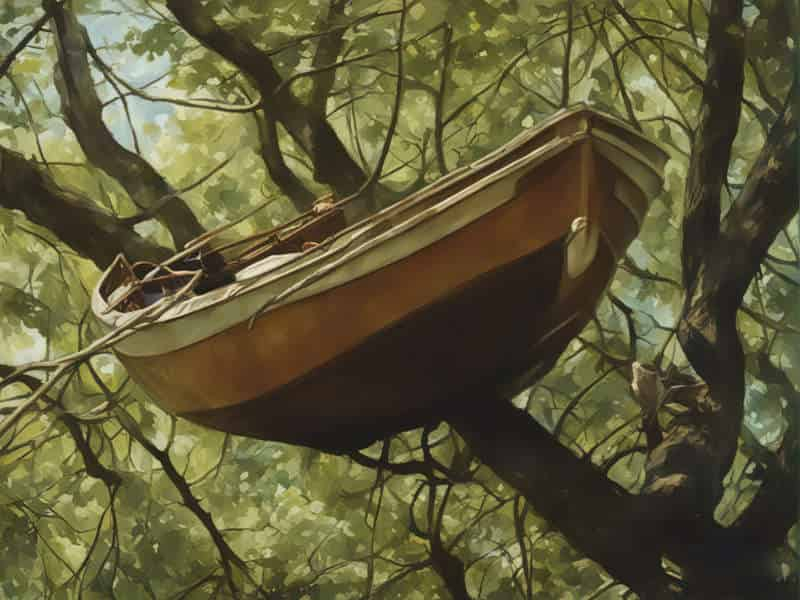
Many stories for children have a carnivalesque story structure:
- The children are at home, probably a bit bored, looking for something to do.
- The children think of something fun to do, and set about doing it.
- An ally in fun turns up (e.g. The Cat in the Hat, the Tiger Who Comes To Tea).
- Hierarchy is overturned. Fun ensues.
- Fun builds.
- Peak Fun!
- Return to the Home State (The Cat in the Hat leaves)
Alice Munro’s “The Found Boat” is not for children, but about children. Munro has not written a fun story for a young audience craving freedom from the strictures of parented lives, but has taken that same carnivalesque structure and subverted it, turning it into feminist commentary with a dystopian ending.
- The girls are minding their own business messing about on a log, meaning to use it as a boat to expand their fantasy lives about going off on a big, worldly adventure.
- Instead of ‘allies in fun’, they encounter three nasty boys from the same class at school. Instead of making the girls’ lives more fun, the boys jeer at them, body shame them, remind them of their bodies, mimic their voices.
- Hierarchy is overturned all right, when the girls hand their found boat over the boys.
- Something has changed in the girls, who have ‘flipped’ from early adolescence (or childhood) into a new, more restricted state of sexualised adolescence, one which is dependent upon boys and their interest. Alice Munro makes sure to populate the town with children who are still very much children, stealing maple syrup (a symbol of sweetness) rather than the more forbidden and hefty theft of a boat. (In a small town, we can consider it theft, given the adolescents could probably locate its owner.)
- From now on it’s the boys who decide what’s happening with the boat. The girls trail along behind or beside them.
- The “Peak Fun” part of the story will be set in a dystopian venue ― an abandoned train station. Exhilaration comes from losing their clothing, which for the girls feels like a return to childhood. However the boys (or at least one of them) don’t see it that way at all. A boy will make it very clear that from now on, the girls’ bodies are sexual.
- The girls return home vowing never to speak the truth of what happened, understanding that if adults knew the truth, the shame would rest entirely on the girls. They have learned to protect the interests of boys at all costs.
ANALYSIS OF “THE FOUND BOAT”
In every short story, Alice Munro includes a detail which feels searingly familiar, sometimes devastatingly so.
I suspect any woman reading this story will recognise the gendered dynamic at play. Two girls, speaking among themselves, are imitated by nearby boys in a mock, high-pitched voice which sounds nothing at all like themselves. Yet they’re powerless to push back against it. The best they can do is ignore it. In many, workaday ways, girls are constantly reminded that they are below the boys in a gender hierarchy which sees boys become bigger and stronger, with deeper, more resonant voices which command attention.
And although these adolescents are playing outdoors, it is somehow still the boys who command ownership of the entire environment. The girls exist on their periphery. From the start, the boys work together to make a raft, the girls make do with a log. The boys want nothing to do with the girls until the girls find something that interests them. In the end, the boat belongs entirely to the boys.
ALICE MUNRO’S VARIETY OF FEMINIST COMMENTARY
It is perhaps frustrating to see how Munro’s girls go along with this, oblivious in real time, to their plight. When the girls find the boat up the tree, they know they cannot get it down by themselves. They understand they’re reliant on the boys, and on whatever feminine powers they can muster to encourage the stronger boys to retrieve it. As helpmates, they are limited in their tasks ― holding the pot of tar ― a task which feels reminiscent of kitchen work, and literally sends Eva back into the kitchen. It is beyond the scope of their gender to do the hard work of restoring the boat.
Why is this frustrating to read? Because Alice Munro does not create the modern Strong Female Character contemporary audiences have too often come to expect. The ‘strong female character’ is a phrase I’ve learned to despise, actually.
Who is the Strong Female Character?
Strong Female Character: A fictional, aspirational girl or woman who understands in real time the gender crap that’s happening around her, and who has perfect verbal comebacks and tricks to win back power in any environment working against her. Strong Female Characters say the things woman audiences wish we could have said. If these women don’t have the height and physical strength of men, they can at least master their weapons to become men’s equal. The Strong Female Character is a fantasy archetype. She appeals to men and women alike, but especially to women, as a wish fulfilment fantasy.
But Alice Munro writes realism, and realism can be uncomfortable. She has written a story of how girls become women and are maligned in the process.
I consider ‘girl’ a different gender from ‘woman’. Gender is a set of characteristics that are socially constructed. The expectations heaped upon girls are quite different from the expectations heaped upon women. Ergo, we all change gender at adolescence. (Not just transgender people.)
Let’s see what happens to Munro’s Eva and Carol as they move from a carefree, magpie-ish childhood in which they are sometimes admitted as equals alongside the boys, into a burgeoning womanhood, where their bodies will be sexualised and objectified for as long as they are considered fertile. From here on in, they will be the helpmate of men, standing by, metaphorically running along the river bank of life.
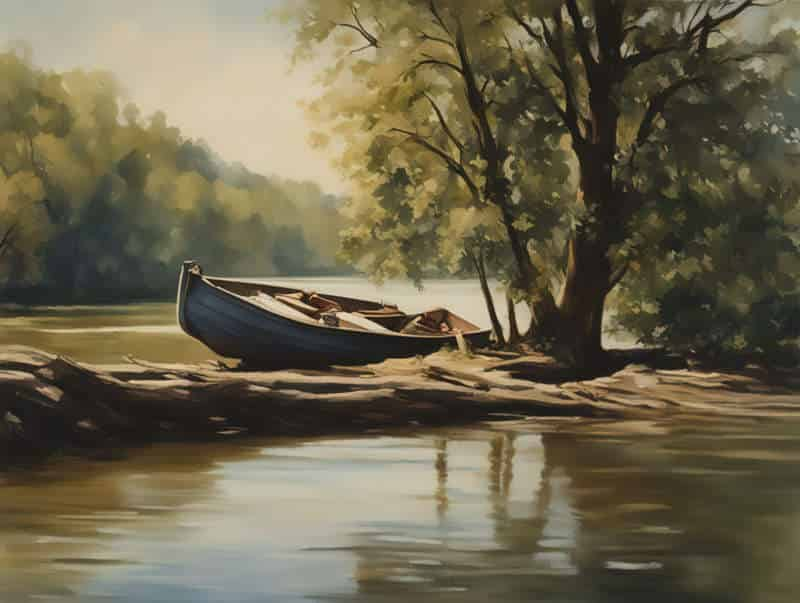
SETTING OF “THE FOUND BOAT”
THE WAWANASH RIVER
Alice Munro has opened with the found boat and deftly established the gender dynamics. Next she takes readers back to the recent past, to the small Ontario town which has recently experienced a flood. If you’ve read Munro’s earlier stories, you’ll be familiar with her fictional town called Jubilee and the nearby Wawanash River, a fictional name for the Maitland River.
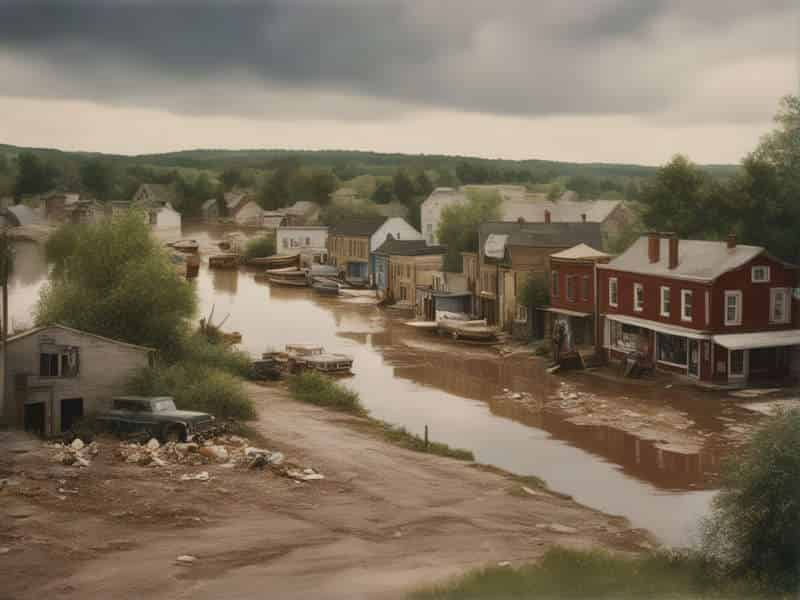
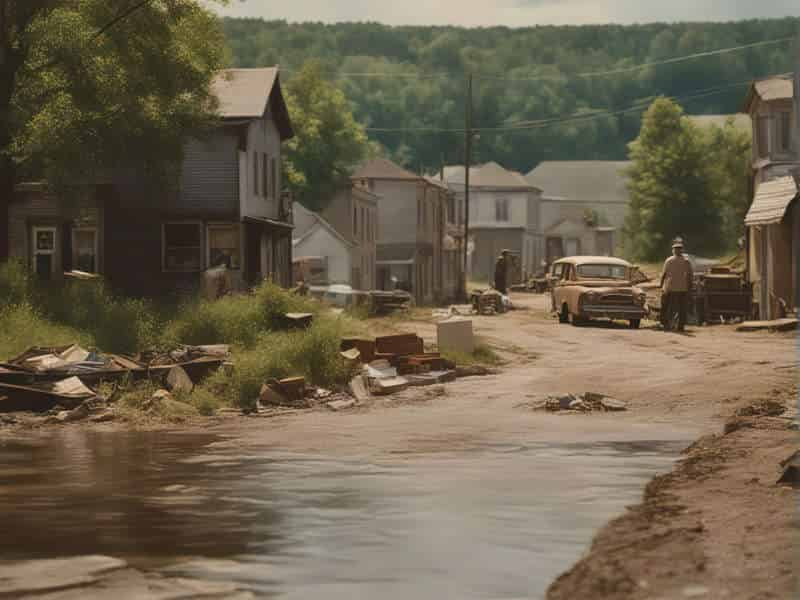
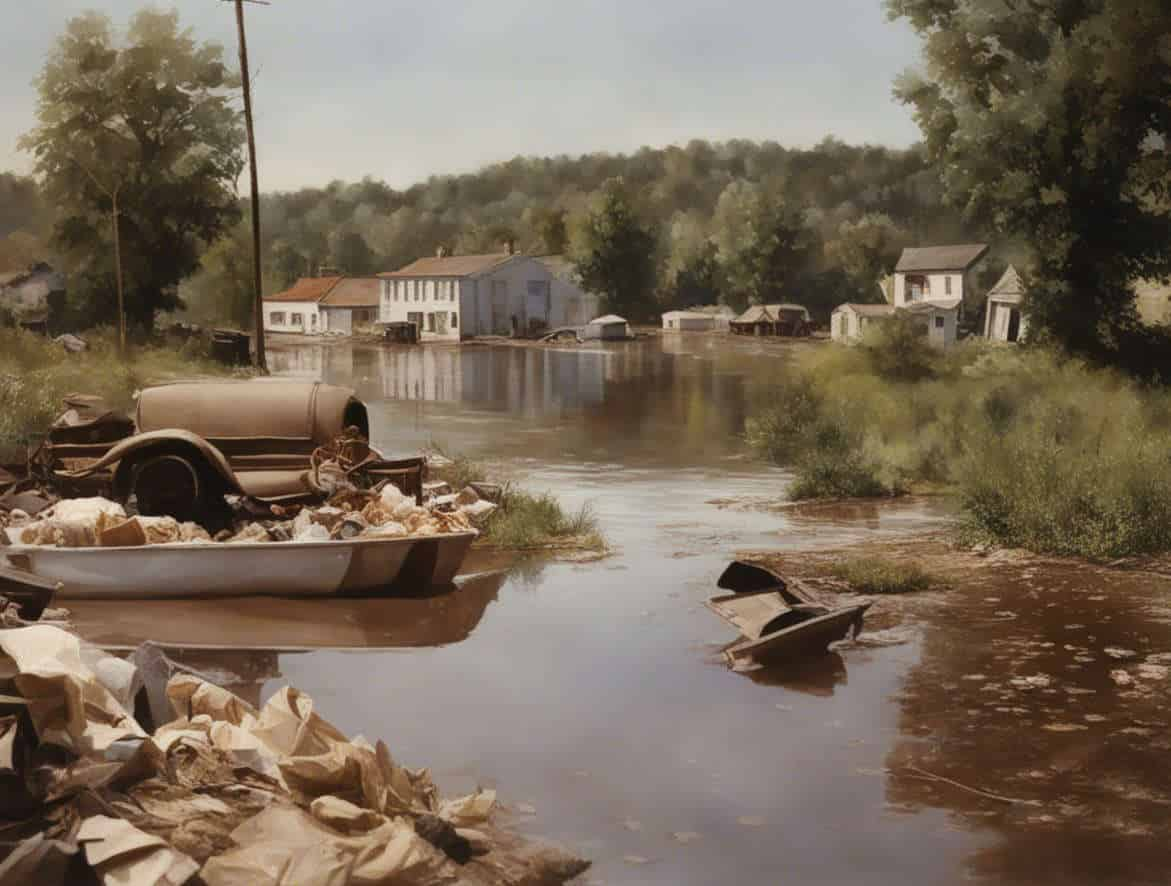
THE RECEDED FLOODWATERS
In this chronologically earlier part of the story, the adolescents behave very much like children, fossicking through found objects thrown up by the flood with childlike glee, more like wild birds than like the civilised adults they will eventually become, no longer interested in floods, but exhausted by them, like their (off-the-page) parents must be.
SUBMERGED OBJECTS COME TO THE SURFACE
There were always things floating around in the Flood ― branches, fence-rails, logs, road signs, old lumber; sometimes boilers, washtubs, pots and pans, or even a car seat or stuffed chair, as if somewhere the Flood had got into a dump.
“The Found Boat”
Notice how Alice Munro has made a list. (Done well, lists are a brilliant yet simple writing technique.)
The first half of that list describes things from the outside world, commonly associated with men and masculinity. After the semi-colon the list is entirely domestic, starting with the sorts of things a young woman might collect for her Hope Chest, leading into a ‘car seat’, suggesting the inevitability of babies. When the boys build the boat, the girls stand around and think up names for it, as if the boat is their baby. (The boys choose none of them.)
There was no name on it, after all. The boys could not imagine that it needed any name to keep it separate from the other boats in the world.
“The Found Boat”, in which the boys consider themselves kings of their own domain, so central to their world that their creation does not require a name.
Later in the story Munro lists other things children find lying around after the thaw:
…old boards and branches, sodden mitts, spoons flung out with the dishwater, lids of pudding pots that had been set in the snow to cool, all the debris that can sift through and survive winter.
“The Found Boat”
Munro has intermingled the domestic with the natural, with domestic items cast by accident out into the snow. Their proper place is inside the home, but the accidental casting out of a spoon or a pudding pot temporarily puts in the minds of the girls other possibilities in which they, too, can enjoy nature rather than provide nurture.
WHEN IS “THE FOUND BOAT” SET?
At first I had thought this story belonged to the 1970s, because the gender dynamics feel mighty familiar from my own 1980s childhood. But details about the lives of the children reveal this is set in an earlier era, probably in the interwar period. (By the by, there’s a theory that Munro wrote it much earlier than the 1970s, but the story only saw publication in 1974.)
Could a similar narrative be set in the 2020s? As far as the gender dynamics go, it absolutely could. However, typically raised children have nowhere near as much freedom now. An entire day out in nature without parental supervision is beyond the ken of city and suburban kids, for sure.
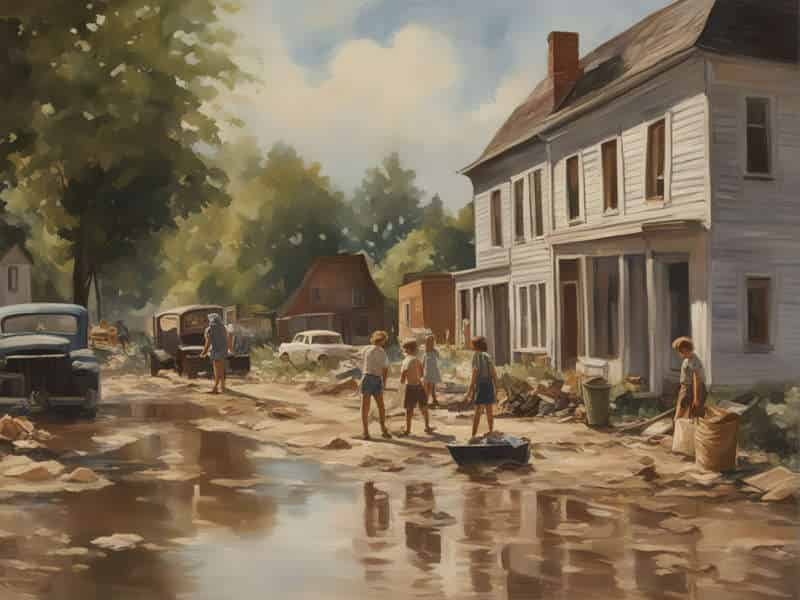
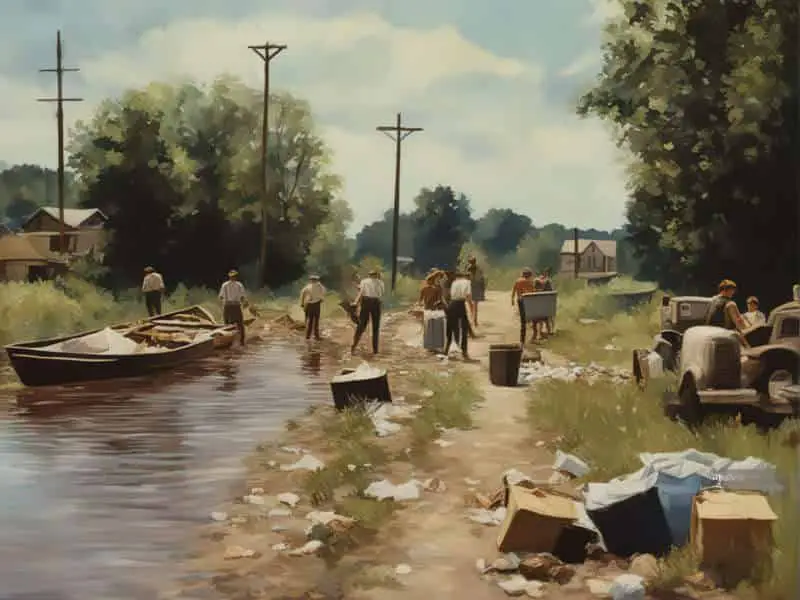
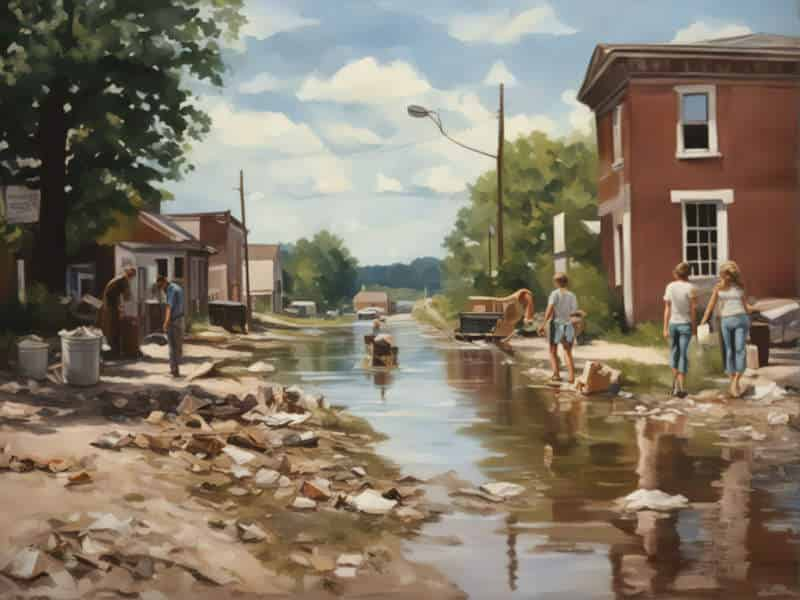
SYMBOLISM OF THE FLOOD
Some springs, say one every five, [the flood] covered the roads on that side of town and washed over the fields, creating a shallow choppy lake. Light reflected off the water made everything bright and cold, as it is in a lakeside town, and woke or revived in people certain vague hopes of disaster.
“The Found Boat” — with one of at least three examples of juxtaposed connotations in a single sentence, culminating in the final sentence of the story.
Floods symbolise various overlapping, interconnected ideas in storytelling. And sometimes, let’s face it, a flood is just a flood ― a feature of rural 20th century Canadian life when snow thaws in spring. But from the opening paragraph (above), Munro is leading us towards river as some kind of symbolism. Paradoxically, unexpectedly, the five-yearly flood ‘revives in people certain vague hopes of disaster‘.
There’s an Evangelical idea that a future metaphorical flood will arrive and wipe out everyone but the True Believers. You don’t have to be a Christian to half-wish for such an event. Anyone who’s seen an episode or two of reality TV show Doomsday Preppers has borne witness to the absolute glee of certain individuals who spend their lives preparing for ― nay ― hoping for, an apocalyptic event which will leave themselves, their own families, their own supplies (and their vast collections of guns) to inherit the Earth. Noah and the Biblical flood is the symbolic stand-in for any number of apocalyptic situations, and every Doomsday Prepper (or ‘survivalist’) seems to have their own unique narrative about what’s likely to end humanity as we know it:
- nuclear war
- biological and chemical warfare
- catastrophic climate change
- ecological collapse
- another pandemic
- supervolcanic eruption
- asteroid impact
- solar geoengineering
- artificial intelligence or robot apocalypse
- the universe stretched apart by a black hole
- solar flares
- massive earthquakes
- the Earth will fall out of orbit
- cataclysmic pole shift
What was the general mindset of rural Canadian communities between the First and Second World Wars? We now call this the ‘interwar period’ but this is a term applied with the knowledge of hindsight. To people living through the 1930s, war was in the air, sure, but they had no idea what was about to play out.
To what extent did this half-knowledge of submerged fears affect a generation of children? Munro tells us in “The Found Boat” that it’s mostly the under 15s and over 65s who show a doomsday-like interest in the flood creeping into the edges of the town. What do these two generations have in common? (Or is it rather that young people and elderly people share most in common, no matter the era?)
The young characters of “The Found Boat” are the adolescents who would come of age just as young people were sent off to be sacrificed during war. Did Alice Munro write these children with their futures in mind? Is it even possible to go off to war if you don’t set out with ‘certain vague hopes of disaster’? These children are exploring their local, familiar environment hoping something will happen. They hope for something, anything to happen ― even a five yearly smalltown flood ― because when you’re young and full of energy, anything is better than nothing.
For the (straight) girls, uncaring boys are better than no boys.
CHILD CHARACTERS OF “THE FOUND BOAT”
THE GIRLS
EVA
If we go with the theory that this story was originally about Del Jordan (from Lives of Girls and Women), then the viewpoint character’s name in “The Found Boat” could have been changed from Del to Eva.
In a story with so much symbolic potential it’s difficult to avoid thinking of Eve from the Biblical Garden of Eden, the original woman who sinned. I mean, we’ve got a (possibly Biblical) flood? It is Eva who accuses the boys of stealing the boat (sinning), then concedes that they’re all in on it since it was the girls who found it. From now on, the boys and girls are complicit in something forbidden ― ostensibly the finding of a boat which surely belongs to someone else. But really, they are complicit in something sexual. They just don’t know it yet. The girls have ‘relinquished something’, Munro tells us via the narration, without telling readers what the girls have relinquished.
THE SUDDEN CHANGE FROM CHILDHOOD TO WOMANHOOD
It soon becomes evident: The girls ‘sit jauntily but not very comfortably’ and look on as the boys work on the boat. The girls are now posing as self-conscious objects of a potential male gaze. Just last week they were unselfconsciously wading through the water with their skirts bunched in front of their groins. Suddenly they are past that forever.
The change can happen very quickly. The film Thirteen (2003) is a harrowing glimpse into how quickly a girl can switch from child to teen. A small incident with the Cool Girl in middle school flips Tracy Freeland into a completely different state of mind. When she throws her stuffed animals from her bed into the bin and refuses to wear ankle socks we know she has changed forever. In Thirteen, as in “The Found Boat”, the sexually promiscuous temptress is named Evie (Zamora). Evie tempts girls as well as boys, for different reasons.
EVA AS BIBLICAL EVE?
Even if we interpret Munro’s Eva as a kind of Biblical Eve, I put it to you that she stands for Woman as a category. Eve’s stand-out feature ends up being her sexualised nakedness, in the way that all women’s nakedness is sexualised.
Eva of “The Found Boat” is also similar to Del Jordan due to her expansive imagination, which must have come from wide reading. (Del’s mother made Del read encyclopedias, remember?) Eva/Del knows about Viking boats, the myth of Atlantis etc., and utilises her knowledge of these big, worldly (or supernatural) things to enrich her fantasy life regarding the very localised flood.
Basically, at the beginning of her (river-as-life) journey, Eva imagines a big, wide world. Importantly, she imagines herself in it. (In the water, in the world.) The girls float along on their crude log and the water could be anything at all. Though the flood waters are shallow, Eva imagines a vast and deep sea. This girl’s hopes and dreams are yet to be shrunk. She is yet to be put in her place.
THE (NON-)SEXUAL MOTIVATIONS OF THE GIRLS
Some commentators have suggested that the two girls originally venture down to the flooded area specifically so the boys will take notice of them. I feel this is an annoyingly masculo-centric reading, and typical of how boys and men too often assume that anything girls do is in service of acquiring male attention.
Moreover, it’s a basic comprehension error to believe that Eva and Carol were hankering after the attention of the boys when they were first messing around with that log. Their interest in the boys comes a bit later, when the girls relinquish not just the boat to the boys, but their personhood. Alice Munro’s narration makes it clear: Eva is not even noticing the boys until she poses as the carving at the front of a Viking boat. She sticks out her chest, accidentally attracting the attention of the boys. She is now forced to notice them back. But her ‘original sin’ is in trying to make a curve to resemble a carving. The boys weren’t part of that fantasy life until they suddenly were.
…and she made a face, putting out her tongue. Then she turned and for the first time took notice of the boys.
“The Found Boat”
THE GIRLS’ WORLD SHRINKS
As the story progresses, we see the girls gradually marginalised in their own natural environment. Although the two girls were the source of the boat (like metaphorical boat-mothers), they immediately lose control of the vessel when the boys get involved. The boys will own, fix and steer the boat. On their excursion down the river, the boys will decide the games. The girls are left to run along the bank, pleading for their turn.
Infuriatingly, as soon as the girls find that boat, they called for the boys who have been so disrespectful to them. Not only that, one of them says, “We found you a boat!” On the one hand, we might conclude the girls have been conditioned to hand anything worthwhile over to the boys. But then we learn that the girls thought to play a trick on the boys as mild retribution. They found a boat all right, but it’s so beat up and irretrievable the boys surely can’t make use of it. To their surprise, the boys are unstoppable. The trio of boys makes immediate plans to restore it, full of confidence that whatever they set their mind to, they will achieve.
CAROL
Carol is a sensible girl, the one who thinks ahead. She has ideas of her own, eventually all around nurturing. We first see her ability to think ahead when she urges the boys to hide the boat where nobody will see it.
GIRLS AS GOOD LITTLE MOTHERS
In stories as in life, girls are often the trustworthy ones who do the research, who have the ideas but who are then cut out of the action. This character has been called the Hermione Archetype, for obvious reasons. Roberta Seelinger-Trites has written extensively about this archetype as she appears in Pixar animated feature films. I see the “Pixar” Maturity Formula absolutely everywhere (and I bet you will too, once you recognise it).
But girls are still children. When the adolescents go out on their river adventure, it is the girls who realise they’ve forgotten some of the supplies. The boys, as far as we know, would never think of taking any food or drinking water at all.
I’m reminded of the scene from Stand By Me in which none of the boys has thought to bring sustenance for an overnight trip into the wilderness. Same-aged girls would be far less likely to make the same error, and in this story, they don’t:
Eva and Carol ran along the bank, carrying bags full of peanut butter-and-jam sandwiches, pickles, bananas, chocolate cake, potato chips, graham crackers stuck together with corn syrup and five bottles of pop to be cooled in the river water. The bottles bumped against their legs. They yelled for a turn.
“The Found Boat”
(In my childhood reading diet which consisted far too heavily of Famous Five adventures by Enid Blyton, it was always Anne who thought of these things, or kept the caravan clean and tidy.)
When Munro tells us in “The Found Boat” that the girls brought five bottles of pop, readers know for sure that that Eva and Carol have prepared an elaborate picnic for all of them, not just for themselves. They have been acculturated into a world in which women look after men, not the other way around. But still they must plead for a turn on the boat.
FOOD AND SEX
In children’s literature, it’s pretty well accepted that food equals sex. Actually, this metaphor doesn’t just apply to children’s stories. In the film Fried Green Tomatoes, the food fight scene between the two main heroines is clearly a Sapphic sex scene. Filmed in 1991, any Sapphic content had to be cloaked for a conservative audience, but it was definitely there for anyone ready to see it. (Contemporary audiences can’t help but see it.)
Likewise, in Munro’s “The Found Boat”, girls provide food for boys. Later, they will provide a sexualised experience for the boys, even though they didn’t necessarily mean to. The picnic foods listed are child-coded items, but the expedition will soon take on a less childlike tone, as the girls head down the river towards the inevitable spectre of Compulsory Sexualisation.
Whereas Eva is happy to remove her clothes, carefree like Eve in the Garden of Eden, the sensible, always-thinking-ahead Carol is less keen. For the first time, this marks a division between the two friends who have, until now, always been in concert, even saying the exact same things.
THE MADONNA/WH*RE DUO IN FICTION
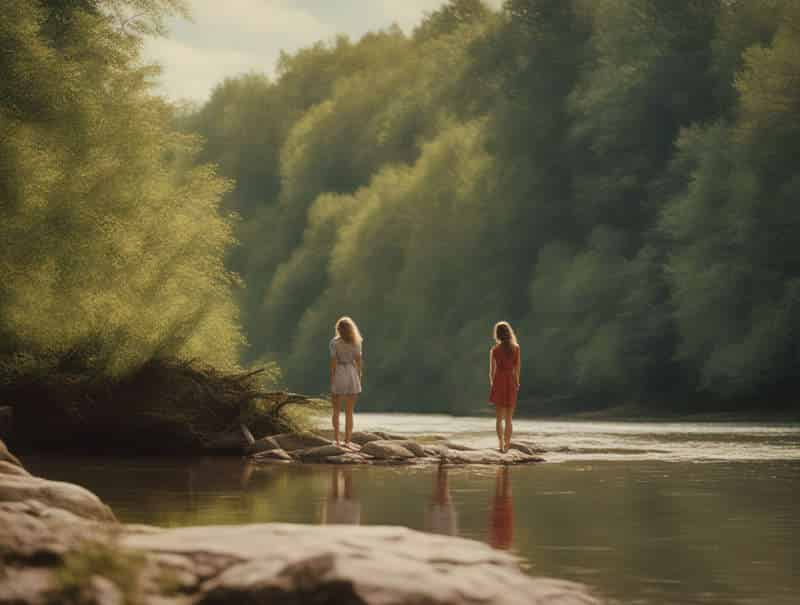
The teen-girl duo in which one is sexual, the other repressed (or lagging behind), is fairly common in storytelling.
American Beauty (1999) subverts this dynamic with the reveal that the supersexual young woman is in fact a virgin, and vulnerable to exploitation by her best friend’s father, whereas the quiet, nerdy friend has been the quietly sexual one all along.
THE BOYS
FRANK
‘The most literate, talkative and inept of the three’ is an interesting collecting of adjectives to describe a single person, yet it works. This boy sounds like a description of Del Jordan’s super smart but socially inept high school boyfriend in Lives of Girls and Women ― the one who invites Del around for dinner and then goes off on his own to study chess moves, leaving Del to be entertained by his mother. Like Del’s smart boyfriend, it is Frank who suggests the clothes come off. In both stories, the nudity includes feelings of shame for the girl(s).
(On the topic juxtaposed connotations and words, refer to the final sentence of the story, in which the girls are left alone laughing their heads off ‘as if they had the worst pain’.)
Frank’s father is the station-master in town, so it is Frank who knows the previous functionality of the abandoned train station. Frank is a sharer of facts. He’s the brains of the trio.
It is Frank who has access to the Popular Mechanics magazines which help the boys to build a boat, even without the mentor of an older man to teach them.
Frank knows to refer to the boat as ‘she’. The girls make ‘fish-mouths of contempt’. Why?
THE GENDERED BOAT
First, why are boats so often gendered ‘she’?
- A grammatical explanation: In Latin, “ship” means “navis,” which is a feminine word. So, making boats female and calling them “she” is an ancient custom of giving genders to inanimate objects.
- A cultural explanation: The majority of sailors in history were male. Their ships were given female names more often, because to give something you love a male name looks suspect in a culture of enforce heterosexuality. It was and still is, common for sailors to name their ships are their wives, mothers, daughters or other women they appreciate.
- A misogynistic explanation: Ships are referred to as ‘she’ because, as a common saying goes, “like a woman, a ship is unpredictable”.
When Eva forms her body into the shape of a carving at the front of a Viking ship, she is knowledgeable about the long tradition in which female figures are thought to be protective. Women, after all, are society’s caregivers and nurturers, so a man’s ship symbolises a womb or a mother’s loving embrace.
That said, the figures at the front of ships were not the mother archetype, but sexually appealing imagery of women. The job of this symbolic sex object was to look after the crew. So she is a blend between the two main roles of a woman in the eyes of men: the mother and the wife.
It makes sense, then, that Eva and Carol experienced a negative gut-reaction to hearing the wrecked and stranded boat referred to as a ‘she’. The reasons are multilayered:
- Until the girls found this boat, the boys had been crudely objectifying and dehumanising them. Now they’ve found a literal object, those same boys immediately honour its ‘humanity’ by giving it a feminine pronoun. What’s more, they’ve immediately switched their attention from the girls to the boat, and are very careful not to do ‘her’ damage as they gently lower her from the branches. By contrast of care, the girls fully understand how little their humanity means to these boys, who literally care more about a wrecked boat.
- By calling the boat ‘she’, the boys have immediately claimed the find, which feels all the worse because the girls found it, and meant the boys to be disappointed by it.
- Eva was minutes earlier immersed in her own private fantasy of floating across a big, wide ocean when she positioned her body into the shape of a Viking carving. But now she is seeing herself through the eyes of boys. Those carvings, (shaped like women) are a small part of a boat (a metaphorical woman) and boats are made by and for male attention. She feels like a vessel.
- Although the girls would only feel this on a deep, unconscious level, boys and men feel protective of their boats because their boats protect them in turn. The girls have been brought up their entire lives to see mothers nurture children ― and husbands ― but care only flows in one direction (like a river ― see where I’m going with this?) Women provide the care; men receive it.
BUD
When it comes to building the boat, Bud is the practical man, in contrast to Frank’s brains. Bud is ‘best at sawing’.
Alice Munro has presented us with boys who are unappealing in their manner but very capable. It is admirable that these young men are able to work together to build something attractive and river-worthy. If she hadn’t done that, we may be left wondering why Eva and Carol would bother with them at all. From Lizzie seeing Darcy’s mansion in Pride and Prejudice to Allie seeing Noah’s house in The Notebook, many a straight woman has been wooed by a man who appeals to her nesting instincts.
CLAYTON
Clayton lives closest to the floodwaters, so I deduce he lives in the least desirable part of town out of all the adolescents. (If the edges of the town floods once every five years, then the poor people will be forced to live in flood prone areas.) Also, we are told his father is dead. The mother does ironing for a living. All day, every day, ironing. Whereas the boys have no male role model, the girls have the likes of Clayton’s mother as a cautionary tale of what happens to them should they fail to secure a husband, who will (supposedly) earn enough to support an entire family.
Readers are told that ‘for some reason’, Eva wants to make a good impression on Clayton’s mother. At this point in Eva’s nascent sexual interest, not even Eva is aware of her crush on Clayton. At night Eva creates an idealised version of Clayton for her own benefit — a boy who speaks nicely to her, or rather, speaks to her in an ordinary voice. Even ‘normal voice’ is too much to hope for in real life. Later, it is Clayton who spits water onto Eve’s breasts and then hoots self-consciously. Then he runs to his friends and although the content of the dialogue is left off the page, readers (and the girls) already know what these boys are capable of saying. They leave on the boat, leaving the girls to walk all the way home along the bank.
During the building process, Clayton listens to Frank explain how to build the boat, but goes about it in his own way, as he surely always has, without the benefit of a father.
For reasons of proximity, the boat is left in Clayton’s back yard. The girls are given the job of shooing interested younger children away as the boys work on the boat.
Is this a sexual metaphor? Meaning, girls are the gatekeepers of sex, with Clayton’s backyard serving as a subverted version of the Garden of Eden?
Note that Munro introduces the boys’ names in brackets, suggesting these boys are archetypes as much as they are individualised by their complementary talents. These boys demand to be acknowledged by the girls, who ignore them when the girls expect the same.
A RURAL VARIATION ON STREET HARASSMENT
Much has been said about so-called street harassment in the post #MeToo era ― when the boys swear at the girls and fat shame them, they are demanding female attention.
American feminist commentator Jessica Valenti grew up in New York City and has written frequently about street harassment. In a 2016 interview she acknowledges that ‘street harassment’ looks different depending on time and place:
I imagine for men reading this book, the long litany of incidents where men sexually harassed you or treated you like a sex object or acted casually entitled to sex or were degrading to you, that must seem unbelievable. But for me, and I imagine for a lot of women, that just felt depressingly familiar. Do you feel that your history is typical for women?
It’s so hard to tell with something like this because obviously the way that we all experience sexism and misogyny is so individualized and so dependent on where we grow up and our class and our race and our sexuality. All of those things matter. But I hope that the story will resonate and I do think that there are some common threads there. From what I’ve heard from a lot of women who have read the book, they did find a lot of stuff familiar even though the book is very New York City-centric. I’m willing to bet that the level of street harassment may not have been the same for who was living in a completely rural area, though maybe I’m wrong. I don’t know. But I think that the spirit of the sexism unfortunately remains the same for a lot of women.
“It was meant to be a reminder to stay in my place”: Jessica Valenti chronicles lessons learned living in a sexist world
Later in the article, the interviewer asks Valenti to talk about the feminine expectation that men’s secrets be kept.
One of the interesting observations that you make in the book is this notion that on top of women getting harassed and sexualized and objectified, there’s this cultural expectation that women are to keep men’s secrets for them. This comes up when you’re much older, you’re married, you have a kid, and you talk about this friend of your family’s coming onto you, and the amount of guilt and pressure you felt to hide his misbehavior. It’s so internalized. I think every woman who gets harassed or worse, sometimes, feels this almost instinctual need to hide that, to protect the guy. Where do you think that comes from?
“It was meant to be a reminder to stay in my place”: Jessica Valenti chronicles lessons learned living in a sexist world
FLOOD SYMBOLISM, OR SOMETHING DIFFERENT?
Let’s return now to the possible symbolism behind the flood. It’s not so much the flooding which is emphasised in this story, but its aftermath ― what it drags up after the water has receded: Receded flood as illuminator of hard truths. The objects which the children found so appealing ― most of all the boat ― are highly ambivalent symbols, because while sex and sexuality is enticing, there’s a whole raft of gendered issues which are hiding just out of view, “below the water”. The log at first allowed these girls to sit on the surface, coasting along playfully. It’s only once they enter deeper waters that difficult dynamics come to light.
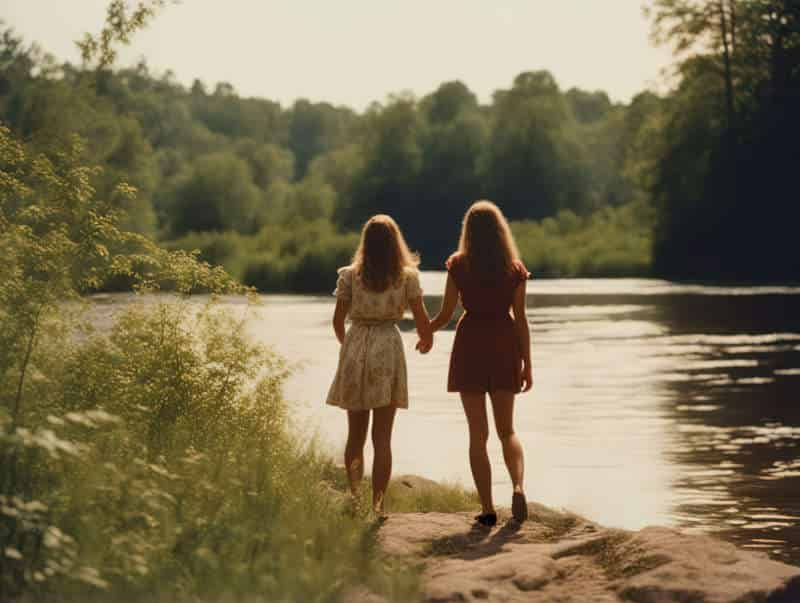
ECOSEXUALITY AND “THE FOUND BOAT”
Let’s talk for a moment about the work of Thomas Hardy, specifically the vexing-as-hell Bathsheba Everdene of Far From The Madding Crowd, who would’ve saved herself a whole lot of bother had she just gone ahead and married Gabriel in the first place.
Of course, she wasn’t ready then, and that’s not her fault. We might even paste an asexual reading onto the character of Bathsheba.
Others have invented their own word to describe Bathsheba’s — or Thomas Hardy’s — treatment of sexuality: Ecosexuality.
Presented as ‘wild’ and as ‘at one with nature’, Hardy’s Bathsheba is way more interested in horses and farm work than she is in getting married and settling down. In fact, settling down with a man terrifies her. It’s only when she’s love-bombed by the soldier that she is briefly, falsely wooed. Big mistake.
Ecosexual works of literature focus on a character’s sexual delight in nature which some might say borders on sexual. Thomas Hardy was a master at it.
Can this word be helpful in understanding Alice Munro’s “The Found Boat”? When Eva and Carol straddle the log, they are enjoying nature. When they explore the trees (and find the boat) they are enjoying nature. Hell, these girls even find pleasure in the mess left after a flood. Later, in the presence of boys, they take off their clothes but not for the sake of the boys. The exhilaration they feel as their skin enters the cold water is a sensory pleasure rather than a sexual one, though their nakedness has an effect on the boys which — to be fair — the boys are not wholly in control of.
Might we also interpret Adam and Eve’s nakedness, in The Garden of Eden, as sensory pleasure in nature which only turns sexual after an encounter with the serpent?
Not caring now about being caught [naked] but in fact leaping and yelling to call attention to themselves, if there was anyboyd to hear or see. They felt as if they were going to jump off a cliff and fly. They felt that something was happening to them different from anything that had happened before, and it had to do with the boat, the water, the sunlight, the dark ruined station, and each other. They thought of each other now hardly as names or people, but as echoing shrieks, reflections, all bold and white and loud and scandalous, and as fast as arrows. They went running without a break into the cold water and when it came almost to the tops of their legs they fell on it and swam. It stopped their noise. Silence, amazement, came over them in a rush. They dripped and floated and separated, sleek as mink.
“The Found Boat” by Alice Munro, in which adolescents become one with nature
In literary studies, there’s more to ‘ecosexuality’ than just ‘enjoying nature in an almost sexual way’. Ecosexuality is a new movement (beginning 2008) in which writers and readers disregard ‘Earth as Mother’, replacing that old metaphor with ‘Earth as Lover’. We must work with nature in order to protect it. We can’t expect ‘nature’ to look after us. This is not a one-way street.
Thomas Hardy is considered an early example of a writer who wrote nature in this more reciprocal way. (Or rather, he was a ‘precursor’ to the movement.)
In Alice Munro’s mid-20th century short story, the boat is basically a womb, providing safety to ‘her’ occupants. But at the story’s conclusion, two real-life girls (alive in the world of the story) remind the boys of the ‘lover’ functionality of girls and women. But unlike 21st century examples of ecosexuality in literature, there’s nothing reciprocal about this. The mother gives; (white) men conquer, build and take.
Munro has offered a critique of ‘mother nature as nurturer’, but has not replaced this metaphor with anything resembling reciprocity. I suspect this is why “The Found Boat” is considered too uncomfortable for anthologization.

